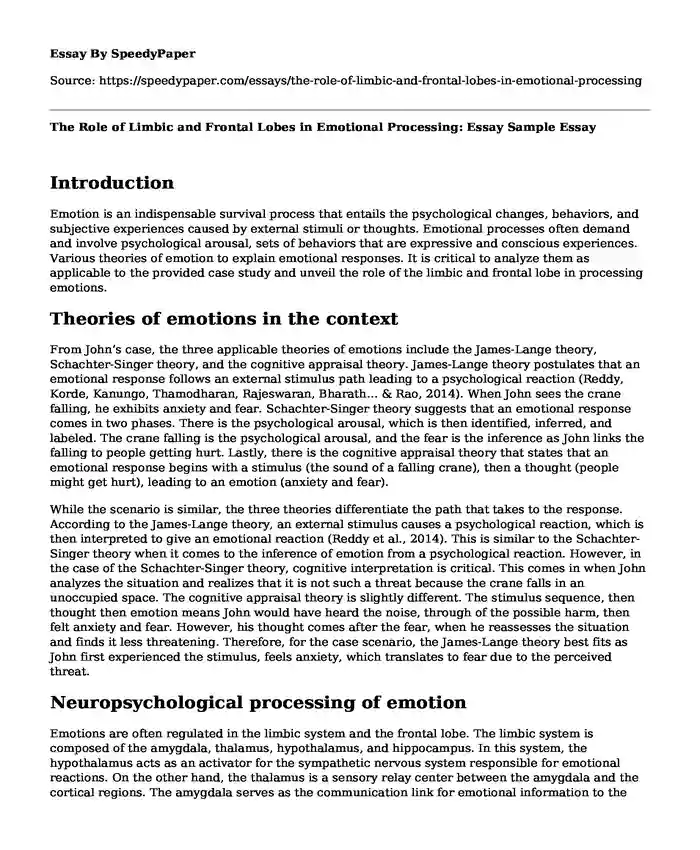
| Type of paper: | Essay |
| Categories: | Psychology Society Emotional intelligence |
| Pages: | 3 |
| Wordcount: | 770 words |
Introduction
Emotion is an indispensable survival process that entails the psychological changes, behaviors, and subjective experiences caused by external stimuli or thoughts. Emotional processes often demand and involve psychological arousal, sets of behaviors that are expressive and conscious experiences. Various theories of emotion to explain emotional responses. It is critical to analyze them as applicable to the provided case study and unveil the role of the limbic and frontal lobe in processing emotions.
Theories of emotions in the context
From John’s case, the three applicable theories of emotions include the James-Lange theory, Schachter-Singer theory, and the cognitive appraisal theory. James-Lange theory postulates that an emotional response follows an external stimulus path leading to a psychological reaction (Reddy, Korde, Kanungo, Thamodharan, Rajeswaran, Bharath… & Rao, 2014). When John sees the crane falling, he exhibits anxiety and fear. Schachter-Singer theory suggests that an emotional response comes in two phases. There is the psychological arousal, which is then identified, inferred, and labeled. The crane falling is the psychological arousal, and the fear is the inference as John links the falling to people getting hurt. Lastly, there is the cognitive appraisal theory that states that an emotional response begins with a stimulus (the sound of a falling crane), then a thought (people might get hurt), leading to an emotion (anxiety and fear).
While the scenario is similar, the three theories differentiate the path that takes to the response. According to the James-Lange theory, an external stimulus causes a psychological reaction, which is then interpreted to give an emotional reaction (Reddy et al., 2014). This is similar to the Schachter-Singer theory when it comes to the inference of emotion from a psychological reaction. However, in the case of the Schachter-Singer theory, cognitive interpretation is critical. This comes in when John analyzes the situation and realizes that it is not such a threat because the crane falls in an unoccupied space. The cognitive appraisal theory is slightly different. The stimulus sequence, then thought then emotion means John would have heard the noise, through of the possible harm, then felt anxiety and fear. However, his thought comes after the fear, when he reassesses the situation and finds it less threatening. Therefore, for the case scenario, the James-Lange theory best fits as John first experienced the stimulus, feels anxiety, which translates to fear due to the perceived threat.
Neuropsychological processing of emotion
Emotions are often regulated in the limbic system and the frontal lobe. The limbic system is composed of the amygdala, thalamus, hypothalamus, and hippocampus. In this system, the hypothalamus acts as an activator for the sympathetic nervous system responsible for emotional reactions. On the other hand, the thalamus is a sensory relay center between the amygdala and the cortical regions. The amygdala serves as the communication link for emotional information to the cortical structures, while the hippocampus links the emotional responses to cognition. The amygdala often received the majority of attention as a fear module, involvement in cortical arousal, vigilance, and affective attention (Pessoa, 2010). The basolateral complex of the amygdala is linked to classical conditioning, while the central nucleus affects attention. The frontal lobe is similarly involved in emotions. The rostral medial frontal cortex (rMFC) is tasked with making sense of the emotions that people feel, including the relevance and salience of these emotions (Waugh, Lemus & Gotlib, 2014). The frontal lobe is thus the emotion control center.
During an emotional response, the amygdala, as the communicator, links the information relayed by sensory cortices with the endocrine, visceral and somatic processes such as fight-and-flight, sweating, and other responses. It responds during frightening and threatening stimuli causing fear and increased alertness. The hypothalamus is the central region for emotional processes. It controls and integrates endocrine, autonomic, and behavioral responses and components.
Conclusion
In conclusion, an emotional response is often a complex process that involves physiological stimuli, behavioral responses, and cognitive processes. These responses are controlled in the limbic system and the frontal lobe. The brain connects these two systems to yield effective, appropriate, salient and relevant emotions relative to the external stimuli present.
References
Pessoa L. (2010). Emotion and cognition and the amygdala: from "what is it?" to "what's to be done?" Neuropsychologia, 48(12), 3416–3429. https://doi.org/10.1016/j.neuropsychologia.2010.06.038
Reddy, R. P., Korde, S. P., Kanungo, S., Thamodharan, A., Rajeswaran, J., Bharath, R. D… & Rao, S. L. (2014). Neural Correlates of Emotion: Acquisition versus Innate View Point. Indian journal of psychological medicine, 36(4), 385–391. https://doi.org/10.4103/0253-7176.140720
Waugh C. E., Lemus M. G. & Gotlib I. H. (2014). The role of the medial frontal cortex in the maintenance of emotional states. doi:10.1093/scan/nsu011
Cite this page
The Role of Limbic and Frontal Lobes in Emotional Processing: Essay Sample. (2023, Nov 15). Retrieved from https://speedypaper.net/essays/the-role-of-limbic-and-frontal-lobes-in-emotional-processing
Request Removal
If you are the original author of this essay and no longer wish to have it published on the SpeedyPaper website, please click below to request its removal:
- American History Essay Sample: Debates on Black Business,1900-1910
- Symbolism in The Paring Knife. Literary Essay Example.
- Sport and Exercise Psychology Essay Sample
- Essay Example on Government Privilege and Immunity
- Free Essay: Impacts of Terrorism on the Global Political Economy of the 21st Century
- That One Weekend. Free Essay Example
- Child Abuse in North America - Essay Example
Popular categories




